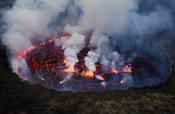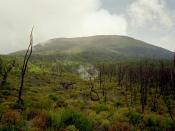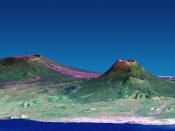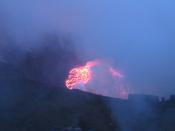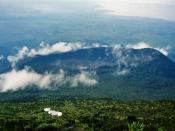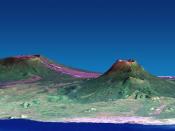Mount Nyiragongo The volcanoes of the world are magnificent and fascinating structures. Some are quiet and some are colossal. Some lay dormant for many years while others erupt on a regular basis. Volcanoes can obliterate entire cities in a matter of minutes. Although it is not particularly well known, Mount Nyiragongo is an important and interesting, as well as a destructive volcano.
Mount Nyiragongo is located in the eastern part of Zaire, or the Democratic Republic of Congo in Africa. It is at a latitude and longitude of 1.5S, 29.3E. Like the majority of African volcanoes, is associated with the East African Rift and is part of Africa's Virunga Volcanic Chain. This mountain chain is one of Africa's most prominent geologic features ("Nyiragongo Volcano, Democratic Republic of the Congo"). With a summit elevation of 11,365 feet, Nyiragongo towers over its neighboring volcano, Nyamlagira, and all of the other surrounding volcanoes ("Nyiragongo Volcanic Eruption").
Nyiragongo is a stratovolcano, also know as a composite cone volcano. A stratovolcano is a tall, steep-sloped, nearly symmetrical volcanic structure. Its andesitic lava is mainly deposited from one enormous central vent. Typically, stratovolcanoes are the most violent type of volcano. Mount Nyiragongo is no exception. Raging fires, fierce tremors, plumes of smoke, and viscous lava flows that can range from one to one-hundred feet wide are all traits of a Mount Nyiragongo eruption. The volcano often spews dust and ash. It is even known sometimes to emit sulfur dioxide into the atmosphere. The large amount of debris in the air at times causes major health problems to the people and wildlife dwelling in the region ("Skies").
Mount Nyiragongo has been very active for at least the last 150 years. The 1,200 meter wide crater contains benches, which mark previous lava lake levels ("Nyiragongo, Democratic Republic of Congo-Zaire"). A lava lake is formed when hot, liquid lava becomes trapped in a depression, or crater formed by an active volcano. A lava lake can be totally melted, but it can also be either partially or fully solidified. Lava lakes usually solidify, or harden, "from the top down and from the bottom up" ("Lava Lakes"). Sometimes a lava lake can take up to thirty years to harden, and they can be up to 400 feet deep ("Lava Lakes").
From 1894 to 1977, a crater at the summit of Niyragongo contained a wide lava lake. On January 10, 1977, the lava lake abruptly drained from fissures in the face of the volcano. The lava traveled toward the nearest city of Goma at speeds of up to 40 miles per hour. Several people were killed, and all of the nearby towns were devastated. The lava lake drained in less than one hour. Again, lava lake activity continued from June 1982 to early 1983. In 1994, part of the crater was filled with a lava lake once again. The 130-foot lake sent lava more than 2,600 feet down the mountainside ("Nyiragongo, Democratic Republic of Congo-Zaire").
The most recent eruption of Mount Niyragongo had a shocking effect. On January 17, 2002, Nyiragongo erupted with remarkable power. There were strong earth tremors about every fifty seconds at the beginning of the eruption. They did not diminish until the next day. Lava spouted out of the southern side of the volcano and traveled at about 1.2 to1.8 kilometers per hour ("Nyiragongo, Democratic Republic of the Congo"). As it flowed, the lava demolished more than fourteen small villages. When the lava reached Goma, it sliced a 200-foot wide path through the City, leveling everything in its path.
Mount Nyiragongo's history is one of violence. Yet, through the destruction, people can watch the forces that are constantly forming the surface of the earth.
Works Cited "Lava Lakes, Tubes, and Fountains". Planetary Exploration. 16 Dec 2001. 8 Oct 2002. http://planetaryexploration.net/jupiter/io/photoglossary/lava_lakes_tubes. html "Nyiragongo, Democratic Republic of Congo (Zaire)". Volcano World-The Premier Source of Volcano Info on the Web. 28 Jan 2002. 8 Oct 2002.
http://www.volcanoworld.org/vwdocs/volc_images/africa/nyiragongo.html "Nyiragongo Volcano, Democratic Republic of the Congo". USGS-Africa Volcanoes and Volcanics. 23 Jan 2002. 8 Oct 2002.
http://vulcan.wr.usgs.gov/Volcanoes/Africa/description_africa_volcanics.html "Nyiragongo Volcano Eruption". Volcano Live. 17-21 Jan 2002. 8 Oct 2002.
http://www.volcanolive.com/news15.html "Skies of Eastern DR Congo Filled with a Scarlet Glow: Mount Nyiragongo Erupts".
Your Dot Com for Africa. 20 Jan 2002. 8 Oct 2002.
http://www.marekinc.com/PhotosNyiragongoerupts.html
